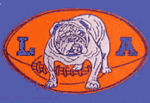 | |
| Founded | 1936 |
|---|---|
| Folded | 1948 |
| Based in | Los Angeles, California and Long Beach, California, United States |
| League | Independent (1936, 1938) American Football League (1937) American Football League (1938) / American Professional Football Association (1939) Pacific Coast Professional Football League (1939–48) |
| Team history | Los Angeles Bulldogs (1936–47) Long Beach Bulldogs (1948) |
| Team colors | Dark Blue, Orange |
| Head coaches | Gus Henderson (1936–37) Ike Frankian (1938–48) Bill Sargent (1945–46) |
| General managers | Harry Myers |
| Owner(s) | Los Angeles region chapter American Legion (1936–37) Jerry Corcoran (1938–48) |
| AFL II Championship wins | 1937 |
| PCPFL Championship wins | 1940, 1946 |
| Mascot(s) | bulldog |
| Home field(s) | Gilmore Stadium (Los Angeles) (1936–46) Veterans Memorial Stadium (Long Beach) (1947) |
The Los Angeles Bulldogs were a professional American football team that competed from 1936 to 1948 (the last year as the Long Beach Bulldogs). Formed with the intention of joining the National Football League in 1937 (and turned down in favor of the Cleveland Rams), the Bulldogs were the first team on the major league level to play its home games on the American West Coast (the NFL's Los Angeles Buccaneers and the first AFL's Wildcats of 1926 were actually traveling teams based in Chicago). They were considered "the best football team in existence outside the NFL".[1]
The 1937 Bulldogs are one of three pro football teams that have gone undefeated and untied during a season, joining the 1972 Miami Dolphins (17–0–0, NFL), and the 1948 Cleveland Browns (15–0–0, AAFC). The Bulldogs hold the distinction of being the first.
The Bulldogs joined the second American Football League, in 1937 and proceeded to become the first professional football team to win a league championship with a perfect record (no losses or ties), having won all eight of its league games that season (counting all exhibition games, they won all 16 of their 1937 contests). After the dissolution of the second AFL after the 1937 season, they returned to independent football for 1938, having a 2–1–2 record against NFL teams that season.
For the 1939 season, the Bulldogs joined fellow second AFL franchise Cincinnati Bengals in joining another American Football League just before the league changed its name to the American Professional Football League. The two newcomers dominated their new league, finishing with the two greatest winning percentages, but at the league meetings, the Columbus Bullies were announced as the league champions.[2] Shortly afterward, the Bulldogs announced their intention to leave the AFL to become a charter member of a new Pacific Coast Professional Football League (the AFL soon dissipated when three more member teams defected to a new league, which soon became the “third American Football League”).
Winning PCPFL championships in 1940 and 1946, the Bulldogs were the only team to compete in the league in every year of its existence (1940–1948). With the establishment of the Los Angeles Rams in the NFL and Los Angeles Dons in the All-America Football Conference in 1946, the popularity of the Bulldogs diminished to the point of moving their home games from Gilmore Stadium to Veterans Memorial Stadium in Long Beach in 1948, and when the attendance dropped below 1,000 people per game, the Bulldogs – and the PCPFL – folded.
- ^ Bob Gill, with Tod Maher. Outsiders: Minor League And Independent Football, 1923-1950, p. 50. St. Johann Press, 2006. ISBN 187828245X
- ^ The Bulldogs: L.A. Hits the Big Time – Bob Gill, Professional Football Research Association (1984)
© MMXXIII Rich X Search. We shall prevail. All rights reserved. Rich X Search
